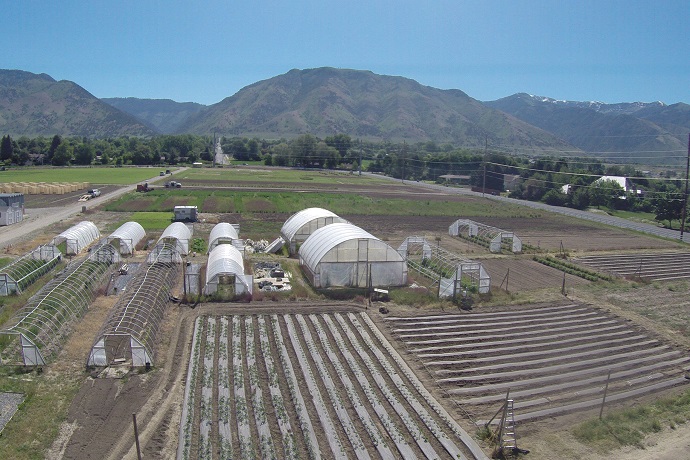High Tunnels
 High tunnels are structures used to improve the growing conditions during early spring and late fall. They significantly increase earliness, total yield potential, and crop quality.
High tunnels are structures used to improve the growing conditions during early spring and late fall. They significantly increase earliness, total yield potential, and crop quality.
High tunnels come in a variety of widths (14-30 feet) and lengths (50-150 feet) and are tall enough so that a person can stand up in part of the structure. Some tunnels are tall enough to accommodate tractors and other equipment. High tunnels are not greenhouses since most are not heated and rely on manual ventilation for temperature control
When considering growing in high tunnels, prior to construction, carefully select the site and location of the structure. Tunnels should be oriented with the ends toward the dominate wind direction. Space them so that they don’t shade each other and with room for snow removal. Remove heavy, wet snow from the top of the tunnels. If left, melting snow will drip into the tunnel along the side walls. This cold water can slow plant growth and make it difficult to manage watering inside the tunnel. Finally, the distance between tunnels should allow for adequate (cross) ventilation.
The keys to successful production of vegetables in high tunnels are crop scheduling, ventilation, and moisture control. When planting in the spring, transplant cold sensitive crops (tomato, pepper, etc.) 3 to 4 weeks earlier compared to the earliest planting date in the field. If you use low tunnels or row covers inside the high tunnel, you can plant five to six weeks before planting outdoors. Invest in a good max/min thermometer and carefully track tunnel temperatures. If cold night temperatures are forecast, use floating row covers, low tunnels, thermal blankets and/or clean burning propane heaters to increase the air temperature. A modest investment in heat can save the crop and ensure early production. Cold damaged plants often do not recover, or if they do, are very late yielding.
High temperatures are managed by careful ventilation. Ventilation is accomplished by opening the doors or rolling up the sides of the tunnel. The goal of growing in high tunnels is to maintain optimum conditions inside without extreme temperature fluctuations. These conditions guarantee early, high yielding and high quality crops. As described with low tunnels, it only takes one high temperature of sufficient duration to significantly reduce the crop's performance. It is important to regularly check and adjust conditions in the tunnel to optimize internal temperatures. Remove the plastic from the high tunnel when the weather gets warm and replace it with 30% shade cloth. Shading has been shown to reduce air temperatures and significantly increase the quality of the crop.
For crops requiring pollination like cucumber or squash, fruit set may be problematic since bees are required to transfer pollen from one flower to another. Bees generally don’t like to fly into or under tunnels. In this case, fruit set is good around the edges of the tunnels but very poor near the centers. Hives can be placed in the tunnels but maintaining the bees there is difficult.
High tunnel production minimizes many diseases by improved water management. With proper ventilation, humidity levels in the tunnel stay low, and since rain is excluded due to the plastic cover, disease incidence is minimal. Even in our dry climate, some diseases (powdery mildew, bacterial diseases, and root rots) can become problematic, particularly when temperatures outside are cool and tunnels are not adequately ventilated. Fungicides (conventional and/ or organic) can be used to manage common tunnel diseases.
For irrigation, use plastic mulches and drip. Most vegetables vary in their seasonal and growth specific water requirements, and these details are included in the individual crop sections.
More Information
- High Tunnel Site Selection (Utah State University Extension)
- Constructing a Low-Cost High Tunnel for Tall Crops (Utah State University Extension)
- Temperature Management in High Tunnels (Utah State University Extension)
How to Build a High Tunnel
Hoop House Construction (Side Walls)
Hoop House Construction (Ends)
Hoop House Construction (Layout)
Hoop House Construction (Ventilation)
Hoop House Construction (Arches)
Hoop House Construction (Covers)

